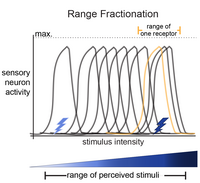Range fractionation

Okay kiddo, have you ever played with LEGOs? You know how you have different kinds of blocks: some are big, some are small, some are flat, and some are shaped like a roof?
Range fractionation is kind of like that, but instead of LEGOs, we're talking about your eyes and your brain. See, your eyes see things at different distances, just like how LEGO blocks come in different shapes and sizes. Some things are close up, like your toys or your family's faces. Other things are far away, like the birds in the sky or the mountains in the distance.
Your brain has to figure out how to see all of these things at the same time, even though they're at different distances. That's where range fractionation comes in. It helps your brain break down all of the things you're seeing into different "blocks" that it can handle more easily.
So when you look around, your brain is constantly sorting the things you see into groups based on how far away they are. This makes it easier for your brain to process all of the information it's getting from your eyes. And just like how putting together a LEGO castle is easier when you have all the right pieces, your brain can make sense of the world around you more easily with range fractionation.
Range fractionation is kind of like that, but instead of LEGOs, we're talking about your eyes and your brain. See, your eyes see things at different distances, just like how LEGO blocks come in different shapes and sizes. Some things are close up, like your toys or your family's faces. Other things are far away, like the birds in the sky or the mountains in the distance.
Your brain has to figure out how to see all of these things at the same time, even though they're at different distances. That's where range fractionation comes in. It helps your brain break down all of the things you're seeing into different "blocks" that it can handle more easily.
So when you look around, your brain is constantly sorting the things you see into groups based on how far away they are. This makes it easier for your brain to process all of the information it's getting from your eyes. And just like how putting together a LEGO castle is easier when you have all the right pieces, your brain can make sense of the world around you more easily with range fractionation.
